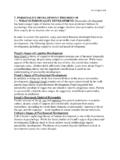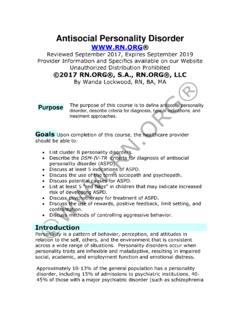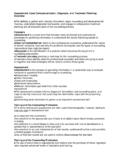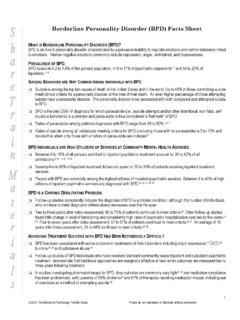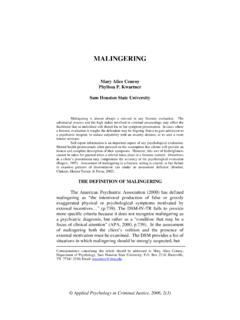Transcription of Hogan Development Survey Manual - Dr.BobHurley
1 Hogan DevelopmentSurvey ManualRobert Hogan , Hogan , Assessment SystemsTulsa, OK 741521997 Copyright 1997 by Robert Hogan , and Joyce Hogan , rights part of this Manual may be reproduced in any form of printing or by any othermeans, electronic or mechanical, including, but not limited to, photocopying,audiovisual recording and transmission, and portrayal or duplication in any informa-tion storage and retrieval system, without permission in writing from Hogan As-sessment Systems, the last five years, a number of people have assisted us with the Development of theHogan Development Survey (HDS). We are grateful for their contributions and it is a plea-sure to acknowledge them. Paul Babiak and Tom-Erik Dybwad commented on the item Thompson created the computer program for the interpretive report and has continuedto refine the scoring systems.
2 Kimberly Brinkmeyer, Doug Klippel, Suzan Rybicki, RobertSmither, and Ron Walker helped gather the original data sets. Suzan Rybicki developed andmaintained the HDS archive and computed the statistical analyses. Heather Heidelberg andDallas Stovall contributed technical assistance and test scoring. Ann Ferguson providedproduction support, and day-to-day help has come from M. Gooch, B. Dings, M. Paddy, andL. M. Gracie. At the University of Tulsa, Judy McHenry produced the written material, includ-ing design, layout, and graphics. We thank all of them for their HoganJoyce HoganTulsa1997 Table of ContentsChapter 1: Conceptual 2 Development 4 Chapter 2: Inventory Construction .. 7 Definitions of the Scales .. 8 Composition of the HDS.
3 9 Chapter 3: Validity .. 13 Construct Validity ..13 Correlations with Other ..14 Skeptical ..15 Cautious ..16 Reserved .. 4: Interpretations and 29 Scale by Scale ..29 Skeptical ..30 Cautious ..31 Reserved .. HDS Profile Moving Away Moving Against Moving Toward Stalker Profile ..43 Fear-driven Salesman 5: Administering and Scoring .. 47 Paper-and-pencil to Administer Paper-and-pencil HDS the Answer the Testing Session ..49 Administrator s Script for Conducting a Testing Session ..49 How to Administer Computer On-line Testing .. the On-line to Score the HDS Answer Data Entry ..52 Optical Scanning of Answer Sheets ..52 Mail-in or FAX Scoring .. 55 List of Tables, Figures, and AppendicesTablesTable Statistics and Reliabilities for the HDS.
4 10 Table Score Means and Standard Deviations for HDS Scales byDemographic 11 Table Scale Intercorrelations .. 11 Table Components Analysis of HDS Scales ..12 Table Between the Hogan Personality Inventory and the Between the MMPI Standard Scales and the HDS ..17 Table Between the MMPI Personality Disorder Scalesand the HDS ..17 Table Between the Motives, Values, Preferences Inventoryand the HDS ..18 Table 3. 5 Correlations Between the Watson-Glaser Critical Thinking Appraisaland the HDS ..20 Table Between the Industrial Reading Test and the HDS ..21 Table Between Observers Description Ratingsand the HDS ..24 Table Components Analysis of the HPI, MVPI, and HDS ..28 FiguresFigure Overlapping Themes from HDS and DSM-IV, Axis 2 Personality 5 Figure A Quick Guide for Interpreting the Average HDS Average HPI Moving Away HDS 4.
5 5 Moving Away HPI Moving Against HDS Moving Against HPI Moving Toward HDS Moving Toward HPI Corporate Stalker HDS Corporate Stalker HPI Litigious HDS Litigious HPI Fear-driven Salesman HDS 5 Fear-driven Salesman HPI Sample Answer HDS Data File Variable A: HDS Norms for the Total B: Sample HDS Interpretive Report ..61 Conceptual Background1C H A P T E R1 Conceptual BackgroundIntroductionThe Hogan Development Survey (HDS) is designed to assess eleven common dysfunctionaldispositions. These dispositions: (a) are caused by people s distorted beliefs about how otherswill treat them; and (b) negatively influence people s careers and life satisfactions.
6 Before de-scribing the Development of the HDS, some background comments may help the reader betterunderstand the purpose of this Freud, Alfred Adler, Karen Horney, and H. S. Sullivan all studied self-defeating behav-ior. However, they explained this behavior very differently. Freud was concerned exclusively withintrapsychic processes events occurring inside the mind whereas the others were concernedwith interpersonal processes events occurring between people. Consequently, the others areknown as interpersonal theorists. Freud thought everyone (who has not been psychoanalyzed) isneurotic; the interpersonal theorists thought that the problems most people have are much lesssevere than a neurosis. Freud thought people could be characterized in terms of how they man-age their neuroses; the others thought people could be characterized in terms of their expecta-tions about how others will treat them.
7 Because some of these expectations are wrong, they tendto behave in ways that others find annoying and that, over time, may interfere with their life s view that everyone is somewhat neurotic is surely incorrect people who are neuroticare severely impaired and most people are not deeply disturbed. Nonetheless, his view pre-vailed and inspired the early history of personality measurement; that, in turn, led to the develop-ment of instruments such as the Minnesota Multiphasic Personality Inventory (MMPI; Hathaway &McKinley, 1943; MMPI 2, Butcher, Dahlstrom, Graham, Tellegen, & Kaemmer, 1989).Adler, Horney, Sullivan and the later interpersonal theorists are probably right in their view that,although everyone is not neurotic, the nature of experience in childhood is such that almost every-one feels inadequate about something.
8 That is, childhood is almost inevitably stressful and mostpeople develop expectations of being criticized in certain situations; theyalso develop methods for dealing with the criticism. For Freud, all neuroses have a single cause a failure to resolve the Oedipus complex; for the interpersonal theorists there are many reasonsfor feeling inadequate, and almost everyone feels insecure about something few of us hadperfect interpersonal theorists have had far less influence on personality assessment than Freud,despite the importance of the problems they analyze. Other than research on the interpersonalcircumplex inspired by Leary (1957) and elaborated brilliantly by Wiggins (1979), there has beenlittle systematic effort to classify the key interpersonal processes.
9 In our judgment, the first step instudying these processes is to develop a taxonomy of what we call dysfunctional dispositions .Horney (1950) identified 10 neurotic needs which seem to be the first taxonomy of flawedinterpersonal tendencies. She later summarized these needs in terms of three themes: (1) mov-ing toward people , managing one s insecurities by building alliances; (2) moving awayfrom people , managing one s feelings of inadequacy by avoiding contact with others; and(3) moving against people , managing one s self-doubts by dominating and intimidatingothers. We believe that Horney s taxonomy is a useful first step in classifying the dysfunctionaldispositions; moreover, it is implicit in the classification of personality disorders contained inDSM-IV (American Psychiatric Association, 1994).
10 HypothesesWe would like to propose as a hypothesis that the DSM-IV, Axis 2 personality disorders canserve as a provisional taxonomy of flawed interpersonal strategies. Like all taxonomies, it issubject to revision as data emerge that cannot be interpreted or incorporated into the would like to propose a second hypothesis, one that concerns the structure of often organize personality variables in a hierarchy defined by many specific behav-iors and/or narrow traits at the bottom and by a few broad and/or general traits at the top. Al-though this is sensible, there is a second natural hierarchy of personality concepts that extendsfrom terms characterizing people with good interpersonal skills, to terms describing flawed skills,to terms referring to non-existent skills.


